May 29, 2025 | 14:24 GMT +7
May 29, 2025 | 14:24 GMT +7
Hotline: 0913.378.918
May 29, 2025 | 14:24 GMT +7
Hotline: 0913.378.918
For over 16 years, I have often gone to the salt fields and heard the happy and sad stories of salt workers in Sa Huynh. These days, the price of salt is high but the weather is so stormy that sighs of regret can be heard almost everywhere.
At noon, Vo Tan Nghi in Pho Thanh ward (Duc Pho town, Quang Ngai) and his wife hurriedly carry shoulder poles to the field. The white crystallized salt fields glisten. Sweat streams down their faces, which have been darkened by the sun and wind. Every now and then, they look back at the clouds rising from the horizon, signaling a summer storm. "The price of salt has gone up, so we have to take advantage of the time to rake, otherwise all the effort we have put in these past few days will be gone. Just raking a few bags of salt is enough for a day's work, so everyone is making the most of it," said Nghi.
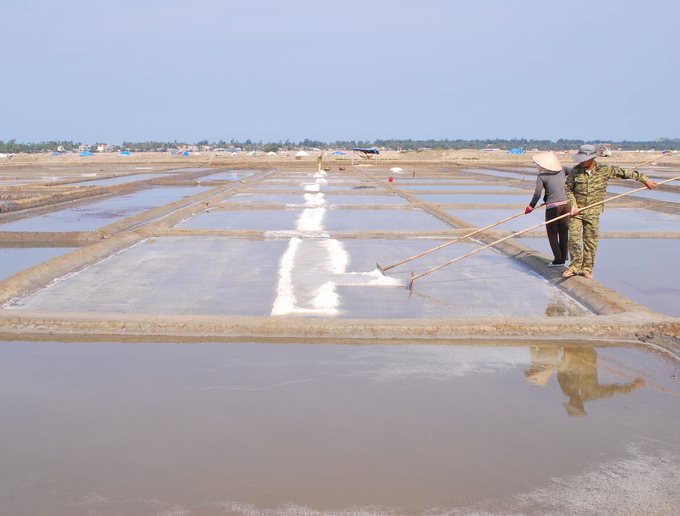
Sa Huynh salt is famous for its deliciousness, but the lives of salt workers have remained difficult for generations. Photo: Vo Thanh Ky.
Suddenly remembering one summer afternoon last year, I was wandering in the salt fields when it started to rain. The first drops of rain fell on the white salt fields that had just crystallized, creating quite a beautiful shape, like tiny lotus leaves attached to white jade, dreamily beautiful and fragile. And, that fragile beauty quickly disappeared after the rain. Salt fields dissolved in water amid the misty rain.
The white salt that had just crystallized after many sunny days of hardship returned to the sea. Sitting close together to take shelter from the rain in a makeshift tent in the middle of the salt field, the salt workers sighed, having their hearts ached in sorrow. They talked in damped tones, mixed with the sound of falling rain. "We salt workers even have to steal the sun and hide the rain,” said Pham Cho.
"Salt production is so hard! A few years ago, when there was a lot of salt, the price per kilo was only VND 400,000 - 500,000, sometimes there were no buyers to be seen. Life was difficult, so many people abandoned their salt fields to find other jobs to make a living," he continued. "This year, the price of salt is high, but the prices of other products have also increased rapidly, so it is still a circle of hardship," Cho's wife, Nguyen Thi Thu Chinh, added.
On an autumn morning 13 years ago, hundreds of salt workers gathered in the yard of Pho Thanh Primary School No. 3 to attend the ceremony to receive and announce the Sa Huynh salt brand. Many elders also came to "see what kind of salt brand all the young people were talking about so happily".
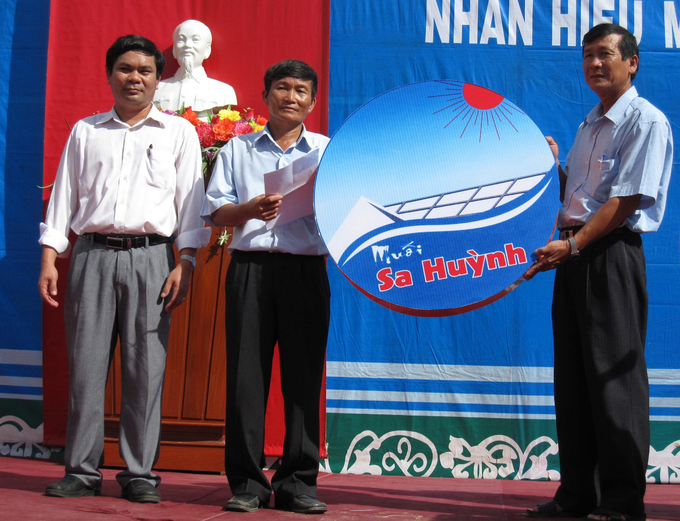
Awarding the logo and decision to recognize the Sa Huynh Salt brand 13 years ago. Photo: Vo Thanh Ky.
It turned out that young people spread the information that Sa Huynh salt was granted a trademark registration certificate by the Department of Intellectual Property (Ministry of Science and Technology). They believed that the recognition of the brand would create favorable conditions for promoting the product, expanding the consumer market, contributing to increasing income and improving the lives of salt workers.
Everyone was elated. They looked attentively towards the stage when the leaders of Duc Pho district (now Duc Pho town) presented the logo and decided to recognize the brand to the salt workers’ representative. Many people dreamed of the price of salt increasing and their lives improving, none of them could hide their happy smiles.
However, salt sales were still sluggish, making many people feel disheartened. "Salt prices are usually low, and only increase before and after Tet. But when prices are high, there is only little salt left. Everyone is short of money, so they cannot wait until the right time. Instead, they have to sell early,” salt worker Tran Son said.

Finding a stable consumption channel for Sa Huynh salt remains an unsolved problem. Photo: Vo Thanh Ky.
On a spring afternoon four years ago, Tran Ngoc Tuyen excitedly called to tell me good news. "A man from Da Nang city came to see me to talk about buying salt for a long time, man! I'm so happy! Finally! A stable sales relationship". The reason was that I wrote an article in the newspaper introducing Sa Huynh salt. After reading it, a reader took the newspaper with them and drove hundreds of kilometers to the salt fields to meet the characters in the article.
They discussed the method of salt production and purchase. However, the two sides could not work together because there was no market for salt products. The functional units of Quang Ngai province also tried to find a place to sell the salt, but the output of the salt grains was still nowhere to be found, making all the efforts come to naught.
When the price of salt dropped, Nghi did many jobs to support his family. Many days, he followed his friends on fishing boats in the coastal waters. They struggled to cast and pull the nets to catch fish and shrimp and sighed together when the nets were empty. On lucky days, he would earn a few hundred thousand dong and the fishermen would share the fresh fish to prepare for family meals. "The salt business is not enough to make a living, so we have to do many jobs, trying to earn more. Who does not go to sea will go spliting rocks, working as loaders, or serving at parties,” he said.
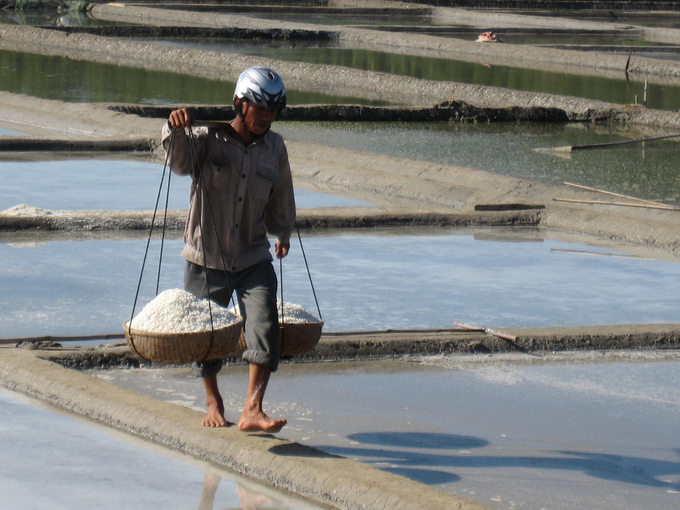
Sa Huynh salt workers still struggle, poverty has haunted them for many years. Photo: Vo Thanh Ky.
Late in the afternoon, Tran Ngoc Tuyen brought nearly 100 net cages to the Sa Huynh saltwater lagoon. He loaded the cages into a basket and rowed a few meters from shore, placing them in the deep blue water to catch fish, shrimp, and crabs. At around 2 a.m. the next morning, he waded into the lagoon to retrieve the cages and bring them home so his wife could bring the fresh seafood to the early market. On a lucky day, he and his wife would earn more than a hundred thousand dong. Some other days the loot was just enough to cook for a meal.
He also worked with his friend installing electrical and water systems. One day, he fell while standing on a high ladder, but he could still joke around. "I've been carrying salt for years without any problems. I just fell while working as an electrician for a short time and now I'm limping. But it's okay, I still carry salt as usual".
Now on the Sa Huynh salt fields in the midday sun, there are only the elderly. The young generation follows fishing boats drifting on the waves of the open sea or leaves the village to other provinces and cities to find a way to make ends meet. "The salt making profession has been passed down from our ancestors, but the young generation now does not want to keep the tradition. We all can endure hardship, but the income is not enough to live on, so the young ones leave for other places. Now I am old and have no job, my only choice is to stick with the salt fields,” salt worker Chau Ro said.
Translated by Samuel Pham

(VAN) Ms. Nguyen Thi Dung, Deputy Director of Ngoc Hoang Cooperative, shared about the journey of bringing dragon fruit to Europe, achieving annual revenues in the billions of VND.

(VAN) Bamboo products from Thang Tho Bamboo Cooperative have reached many countries around the world, while also creating jobs for local workers.
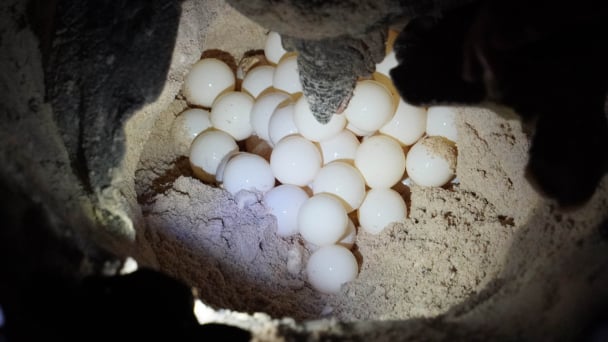
(VAN) The Management Board of Con Dao National Park reported that a green sea turtle, tagged in the Philippines, has traveled thousands of kilometers to lay 84 eggs on Bay Canh Islet.
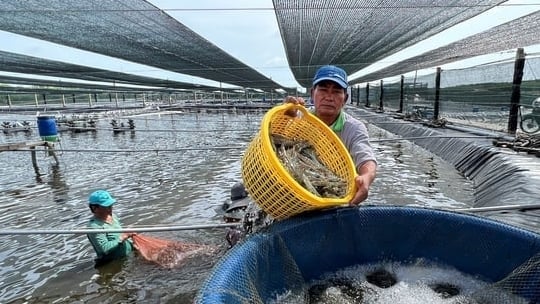
(VAN) Green technology is paving a new path for sustainable aquaculture in the Mekong Delta in particular and across the country in general, helping reduce emissions and adapt to climate change.
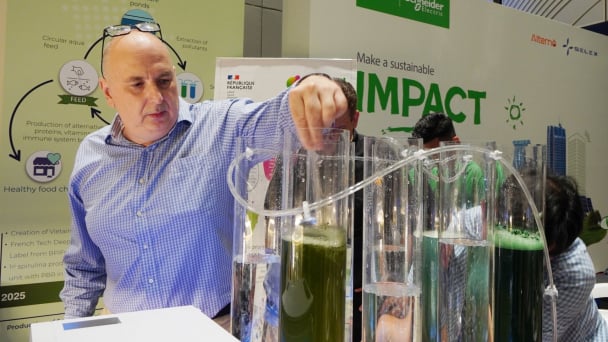
(VAN) On May 27, La French Tech Vietnam (the French startup and innovation community in Vietnam) held the French Tech Summit Vietnam 2025.
/2025/05/27/4731-2-223159_980.jpg)
(VAN) No votive paper, no styrofoam, no plastic bags, no plastic bottles, and no single-use plastic trays are the key rules tourists should keep in mind when visiting Con Dao.
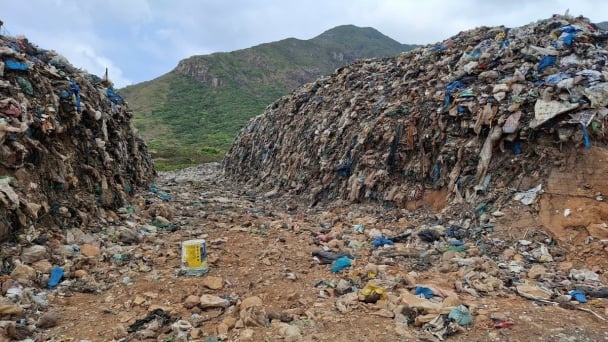
(VAN) In the fight against plastic pollution, Vietnam has been demonstrating a proactive, pioneering, and active role in addressing the greatest environmental challenge today.